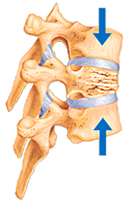Spinal Compression Fractures
Find your care
At the UCLA Health Spine Center, our experts diagnose, manage and treat all spinal injuries and conditions. Call 310-319-3475 to connect with a spine specialist.
Fax: 424-259-6560
What You Should Know About Spinal Compression Fractures
Compression Fracture of the vertebral body is common, especially in older adults. Fractures are usually caused by osteoporosis, and range from mild to severe. Vertebral compression fractures occur when the weight of the upper body exceeds the ability of the bone within the vertebral body to support the load. Generally, a compression fracture is the result of some type of trauma. More severe osteoporosis can allow fractures to develop from even minor trauma. Up to 30 percent of compression fractures occur while the patient is in bed.

Symptoms
Spinal compression fractures can be insidious and may produce only modest back pain early in the course of progressive disease. Over time, multiple fractures may result in significant loss of height. Progressive loss of stature results in the shortening of the paraspinal musculature requiring prolonged active contraction for maintenance of posture, resulting in pain from muscle fatigue. This pain may continue long after the initial fracture has healed. Patients develop thoracic (mid back) kyphosis and lumbar lordosis (sway back) as vertebral height is lost. More severe fractures can cause significant pain, leading to an inability to perform activities of daily living, and a life-threatening decline in the elderly patient who already has decreased reserves.
Diagnosis
Only about one-third of vertebral fractures are actually diagnosed, because many patients and families regard back pain symptoms as arthritis or a normal part of aging. Therefore, a compression fracture should be suspected in any patient older than 50 years with sudden onset of mid- or low-back pain. Most patients will remember a specific injury as the cause; however, fractures may occur without any history of increased force on the spine. While the diagnosis can be suspected from history and physical examination, plain x-rays, as well as a CT scan or MRI, are often helpful in accurate diagnosis and prognosis.
Treatment
Traditional conservative treatment includes bed rest, pain control, and physical therapy. Lying flat on the back generally relieves some of the discomfort, whereas walking can aggravate it. Interventional procedures such as vertebroplasty can be considered in those patients who do not respond to initial treatment. Vertebroplasty is a procedure in which a plastic material that hardens after injection is introduced into the vertebra under x-ray control. Rarely, corrective surgery is indicated for severe thoracic kyphosis that does not lend itself to vertebroplasty.